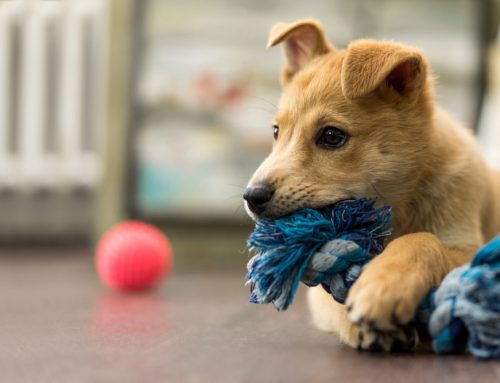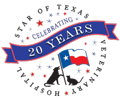Puppies fill a home with laughter and love, but they also bring a supernatural amount of energy that may have you desperately looking for their off-switch. Whether you are already practicing your puppy’s basic skills at home, or feeling completely overwhelmed and exhausted, Star of Texas Veterinary Hospital has assembled the following five-step guide, to help you get your active puppy on the right track to becoming a well-behaved adult.
#1: Establish and maintain a daily routine for your puppy
Dogs thrive in environments where they can predict what’s next. Reliable daily routines allow your puppy to feel safe and confident, which naturally improves behavior. When puppies know what is expected from them each day, they are less likely to experience frustration and stress, which can lead to destructive behaviors, and excessive vocalization (i.e., whining, howling, barking).
Your puppy’s daily routine should include:
- Consistent meal times
- Regular sleep and wake times
- Appropriate physical activity
- Quality social time with you or other family members
- Being crated and alone for brief intervals
- Several two- to three-minute training sessions
#2: Have realistic expectations for your puppy
Puppies do not naturally understand how to behave in a human world. They will naturally explore their environment “teeth-first,” jump, and bark, and have no concept of walking on a leash. Many actions that humans consider inappropriate are perfectly normal canine behaviors.
When your puppy is behaving in an undesirable way, they are not rebelling or being bad. Poor behavior is your puppy’s way of telling you that they have not been shown the right way, or their training was unclear or inconsistent. Mistakes are to be expected. Focus on ignoring bad behavior, and rewarding appropriate behavior. At no point should you scold or strike your puppy—this will cause fear and distrust, and may worsen their behavior.
#3: Provide your puppy with regular and age-appropriate exercise
Physical activity is critical to promoting your active puppy’s good behavior. Exercise must be consistent (i.e., multiple short sessions daily), and age-appropriate. Growing puppies are susceptible to physical harm, especially at their growth plates, if their exercise exceeds their strength and stamina.
Growth plates are the active bone development areas at either end of long bones (e.g., femur, humerus), which remain open until approximately 12 to 18 months of age. High-impact activities, such as jogging on asphalt, jumping, hill running, and repetitive fetch or flying disc games, can damage growth plates, and cause premature closure. When growth plates close too early, the damaged bone will be shortened, which places unnatural strain on joints and ligaments, potentially causing injury and arthritis.
Your veterinarian can provide customized exercise recommendations for your puppy based on their age and breed, but basic guidelines for safely exercising puppies include:
- Exercising on level ground with good footing, avoiding slippery floors
- Playing with appropriately matched puppies or dogs (i.e., equal size or energy levels)
- Avoiding concussive activities, such as jumping from heights
- Avoiding repetitive movements
- Limiting exercise duration
#4: Enroll in puppy classes to learn foundation manners and life-skills
Whether or not you realize, your puppy is constantly learning. Puppies are incredibly observant, and learn by action and consequence. Behaviors that are rewarded, either by you or by the environment (e.g., counter surfing equals free food), get repeated, and grow stronger, while unrewarded behaviors naturally extinguish. Puppy training classes, such as Puppy Start Right at Star of Texas Veterinary Hospital, can help you learn to communicate with your puppy so they learn only what you want. Our positive-reinforcement based classes provide everything you need to equip yourself and your puppy for a lifetime of success, including:
- Puppy socialization
- Crate training
- Growth and development
- Basic foundation skills (e.g., come, sit, down, stay)
- Problem-solving for common puppy behaviors, such as jumping, chewing, and house soiling
#5: Stimulate your puppy’s mind with enrichment activities

When they think about exercise, most puppy owners think about physical exertion, but may overlook one of the most powerful ways to satisfy a growing puppy—engaging the mind. Games and activities that require your puppy to problem solve, or to use their nose to sniff out hidden food, activate the seeking circuit in the brain, which in turn releases dopamine. Enrichment games are inherently rewarding for puppies, and are often followed by a long nap.
Enrichment can take many forms, but you should allow your puppy to engage in natural canine behaviors in a safe, controlled manner. Some popular, easy enrichment strategies include:
- Unstructured leash walks in a new area, where your puppy is allowed to sniff and explore
- Introducing new objects to your puppy’s environment (e.g., child’s play tunnel, cardboard boxes)
- Slow-feeder bowls, or lickable mats
- Food stuffed toys, such as Kongs
- Puzzle toys
- Snuffle mats
- A designated outdoor digging pit
Always supervise your puppy with food toys, to prevent inappropriate use. Consistently applied enrichment activities will improve your puppy’s behavior by preventing boredom, building value for delayed rewards, providing an outlet for natural behaviors, and burning off excess energy.
Despite how it may feel, puppyhood is temporary, and soon enough a fully grown adult dog will take the place of your wiggly tornado of a puppy. Enjoy the early days while they last, and prepare for a long and beautiful friendship by starting your puppy off right. Star of Texas Veterinary Hospital wants to help, so contact us for more information about our training classes, or to schedule your puppy’s next appointment.






